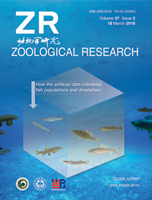
|
Zoological Research
Kunming Institute of Zoology, Chinese Academy of Sciences
ISSN: 2095-8137
Vol. 36, No. 6, 2015, pp. 342-347
|
 Bioline Code: zr15040
Bioline Code: zr15040
Full paper language: English
Document type: Report
Document available free of charge
|
|
|
Zoological Research, Vol. 36, No. 6, 2015, pp. 342-347
| en |
Patterns of reptile and amphibian species richness along elevational gradients in Mt. Kenya
Malonza, Patrick Kinyatta
Abstract
Faunal species richness is traditionally assumed to decrease with increasing elevation and decreasing primary productivity. Species richness is reported to peak at mid-elevation. This survey examines the herpetofaunal diversity and distribution in Mt. Kenya (central Kenya) by testing the hypothesis that changes in species richness with elevation relate to elevation-dependent changes in climate. Sampling along transects from an elevation of approximately 1 700 m in Chogoria forest block (wind-ward side) and approximately 2 600 m in Sirimon block (rain shadow zone) upwards in March 2009. This starts from the forest to montane alpine zones. Sampling of reptiles and amphibians uses pitfall traps associated with drift fences, time-limited searches and visual encounter surveys. The results show that herpetofaunal richness differs among three vegetation zones along the elevation gradient. Chogoria has higher biodiversity than Sirimon. More species occur at low and middle elevations and few exist at high elevations. The trends are consistent with expected optimum water and energy variables. The lower alpine montane zone has high species richness but low diversity due to dominance of some high elevations species. Unambiguous data do not support a mid-domain effect (mid-elevation peak) because the observed trend better fits a model in which climatic variables (rainfall and temperature) control species richness, which indirectly measures productivity. It is important to continue protection of all indigenous forests, especially at low to mid elevations. These areas are vulnerable to human destruction yet are home to some endemic species. Firebreaks can limit the spread of the perennial wildfires, especially on the moorlands.
Keywords
Herpetofauna; Rainfall; Species diversity; Elevation; Temperature
|
| |
© Copyright 2015 - Zoological Research
Alternative site location: http://www.zoores.ac.cn/
|
|
